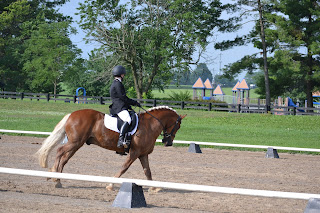In today's post, I'm covering how it's actually worked out in real life. We've had it for two weeks at this point.
 |
| Dog for scale |
They reached out to make sure I was aware of what grate size it came with, to ask what type of hay I was using, and went WAY out of their way to make sure I wasn't getting the wrong product. We probably exchanged over 20 emails after I ordered and before it shipped. It shipped out Tuesday from Iowa, and arrived Wednesday.
 |
| Great customer service and product, questionable graphic and web design choices |
The horses had already been fed when I got it to the barn, and I had to laugh at Connor giving me a sign that I was doing the right thing (if not by him, by my trainer who buys our hay!):
It comes with instructions on how to introduce your horse to the feeder. They err on the side of assuming the horse might be frustrated with the feeder.
I found loading it to be super easy, and my trainer and our barn workers agree. As shown in the images above and below, you flip it over, pull the springloaded pin that secures the bottom, slide the bottom over, drop the hay in, and replace the bottom and pin.
The feeder is big and sturdy, but light enough that it wasn't hard for me to carry it around. I can definitely see taking it to shows without issue.
 |
| From top to bottom: bottom shown with cover slid out, top shown filled with hay, and the springloaded pin on the side that keeps the bottom in place. |
The grate is secured to the sides with "heavy black fabric" (vinyl?), which allows the grate to move up and down as the amount of hay in the feeder changes. The grates are replaceable and come in 3 sizes.
The size shown here is the medium size, which is recommended for "most grass and grass alfalfa mix hay. Not for very thick or coarse hay such as first cutting alfalfa or peanut hay," and also for introducing horses to the feeder.
 |
| Small is for soft/fine grass hays like Bermuda, medium (shown) is for most grass/grass alfalfa mixes, and large is for stemmy alfalfa, peanut hay and old horses that have a tough time grabbing hay. |
Connor took to it immediately. I knew he would, and I was pretty lazy about introducing it to him. I put hay in there, pulled some through the holes, and sat on a stool in his stall for a half hour, watching him munch hay and listening to the rain on the barn roof.
 |
| I gave it to him on Valentine's Day, and texted JenJ "Roses are red, violets are blue, I made your dinner harder to eat, haha poor you." |
I've been happy with it so far. It's no small hole hay net, but it definitely takes him longer to get a bite out than free-choice does (video below). I may get the small grate at some point to experiment with slowing him down even further. I haven't timed it, but he's taking longer to finish his hay in general now. He's also wasting far less hay than before.
The biggest downside is that it is specifically designed not to be secured to the wall, which means at first Connor's stall was a disaster as he pushed it around to see if that would get the hay out easier. His stall has gotten better with time as he gets better at eating out of it and has stopped pushing it around so much.
Here are two short video clips of Connor eating out of the feeder:
Bottom line: This is totally my pick for a slow feeder haynet alternative. I don't feel like I compromised on anything with this one, and it's doing exactly what I hoped it would do. I personally feel like it's the best on the market unless you need to soak your hay inside the feeder, in which case you should consider something like the PortaGrazer.
What: Savvy Feeder
Price: $299 (new), $274 (factory seconds). They regularly offer 10%-14% off coupons around holidays with a maximum coupon of 20% off on Black Friday.
Grate size choices: Small (soft/fine hays like Bermuda), Medium (most grass hays and grass/alfalfa blends, also recommended for introducing horses to feeder before using small grate) and Large (stemmy alfalfa, peanut hay, and feeders that will be used by senior citizens)
Colors: Dark grey, light grey and tan are standard, but they have occasionally had limited runs of other colors, such as red, lime green and teal.












































































